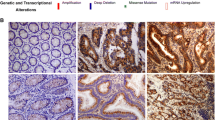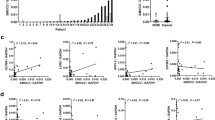Abstract
Stanniocalcin 2 (STC2) is a novel member of the Stanniocalcin family, the function of which remains unclear. Its expression is clinically significant in several cancers. The aim of this study was to evaluate the clinical value of measuring expression levels of STC2 in colorectal cancer (CRC) patients. A total of 47 tumor and matched tumor-free margin samples were obtained during surgery. The STC2 mRNA expression level in tumor and marginal tissue was examined by real-time quantitative PCR. STC2 mRNA expression levels were higher in tumor tissues than the control. (r = 0.36, p ≤ 0.02). mRNA expression level of STC2 was significantly associated with tumor size (p ≤ 0.05) and histologic grade (p ≤ 0.05). Our study demonstrated that STC2 was significantly expressed in CRC patients, relative to the control. STC2 can therefore be used as a biomarker to differentiate between tumor borders and margins. Analysis of STC2 gene expression during surgery could be useful in reducing surgical error in tumor removal and increasing overall success of surgery with improved tumor clearance. However, in some cases such as where the tumor is end-stage, the expression of such a biomarker may not be clinically beneficial to record. The consideration of marginal samples as a control group can help reduce the effect of confounding factors such as racial and individual differences.




Similar content being viewed by others
References
Jemal A, Murray T, Ward E, Samuels A, Tiwari RC, Ghafoor A, et al. Cancer statistics, 2005. CA Cancer J Clin. 2005;55(1):10–30.
Ferlay J, Bray F, Pisani P, Parkin D. IARC cancer base no. 5 Version 2.0. Lyon: IARC Pr 2004.
Alireza S, Mehdi N, Ali M. Cancer occurrence in Iran in 2002, an international perspective. Asian Pac J Cancer Prev. 2005;6(3):359.
Malekzadeh R, Bishehsari F, Mahdavinia M, Ansari R. Epidemiology and molecular genetics of colorectal cancer in Iran: a review. Arch Iran Med. 2009;12(2):161–9.
Moghimi-Dehkordi B, Safaee A. An overview of colorectal cancer survival rates and prognosis in Asia. World J Gastrointest Oncol. 2012;4(4):71.
Ghossein RA, Rosai J. Polymerase chain reaction in the detection of micrometastases and circulating tumor cells. Cancer. 1996;78(1):10–6.
Pelkey T, Frierson H, Bruns D. Molecular and immunological detection of circulating tumor cells and micrometastases from solid tumors. Clin Chem. 1996;42(9):1369–81.
Stannius H. Nebennieren bei knochenfischen. Archiv fu¨r Anatomie und. Physiologie. 1839;6:97–101.
Yeung B, Law A, Wong CK. Evolution and roles of stanniocalcin. Mol Cell Endocrinol. 2012;349(2):272–80.
Wagner GF, Dimattia GE. The stanniocalcin family of proteins. J Exp Zool Comp Exp Biol. 2006;305(9):769–80.
DiMattia GE, Varghese R, Wagner GF. Molecular cloning and characterization of stanniocalcin-related protein. Mol Cell Endocrinol. 1998;146(1):137–40.
Chang A-M, Reddel RR. Identification of a second stanniocalcin cDNA in mouse and human: stanniocalcin 2. Mol Cell Endocrinol. 1998;141(1):95–9.
Ishibashi K, Miyamoto K, Taketani Y, Morita K, Takeda E, Sasaki S, et al. Molecular cloning of a second human stanniocalcin homologue (STC2). Biochem Biophys Res Commun. 1998;250(2):252–8.
McCudden CR, James KA, Hasilo C, Wagner GF. Characterization of mammalian stanniocalcin receptors mitochondrial targeting of ligand and receptor for regulation of cellular metabolism. J Biol Chem. 2002;277(47):45249–58.
Raulic S, Ramos-Valdes Y, DiMattia GE. Stanniocalcin 2 expression is regulated by hormone signalling and negatively affects breast cancer cell viability in vitro. J Endocrinol. 2008;197(3):517–29.
Moore E, Kuestner R, Conklin D, Whitmore T, Downey W, Buddle M, et al. Stanniocalcin 2: characterization of the protein and its localization to human pancreatic alpha cells. Horm Metab Res. 1999;31(07):406–14.
Wong C, Yeung H, Mak N, DiMattia G, Chan D, Wagner G. Effects of dibutyryl cAMP on stanniocalcin and stanniocalcin-related protein mRNA expression in neuroblastoma cells. J Endocrinol. 2002;173(1):199–209.
Jellinek D, Chang A, Larsen M, Wang X, Robinson P, Reddel R. Stanniocalcin 1 and 2 are secreted as phosphoproteins from human fibrosarcoma cells. Biochem J. 2000;350:453–61.
Meyer H-A, Tölle A, Jung M, Fritzsche FR, Haendler B, Kristiansen I, et al. Identification of stanniocalcin 2 as prognostic marker in renal cell carcinoma. Eur Urol. 2009;55(3):669–78.
Tamura K, Furihata M, Chung SY, Uemura M, Yoshioka H, Iiyama T. Stanniocalcin 2 overexpression in castration-resistant prostate cancer and aggressive prostate cancer. Cancer Sci. 2009;100(5):914–9.
Ieta K, Tanaka F, Yokobori T, Kita Y, Haraguchi N, Mimori K, et al. Clinicopathological significance of stanniocalcin 2 gene expression in colorectal cancer. Int J Cancer. 2009;125(4):926–31.
Volland S, Kugler W, Schweigerer L, Wilting J, Becker J. Stanniocalcin 2 promotes invasion and is associated with metastatic stages in neuroblastoma. Int J Cancer. 2009;125(9):2049–57.
Mori M. STC2: a predictive marker for lymph node metastasis in esophageal squamous-cell carcinoma. Ann Surg Oncol. 2011;18(1):261–72.
Yokobori T, Mimori K, Ishii H, Iwatsuki M, Tanaka F, Kamohara Y, et al. Clinical significance of stanniocalcin 2 as a prognostic marker in gastric cancer. Ann Surg Oncol. 2010;17(10):2601–7.
Wang Y-Y, Li L, Zhao Z-S, Wang H-J. Clinical utility of measuring expression levels of KAP1, TIMP1 and STC2 in peripheral blood of patients with gastric cancer. World J Surg Oncol. 2013;11(1):81.
Bouras T, Southey MC, Chang AC, Reddel RR, Willhite D, Glynne R, et al. Stanniocalcin 2 is an estrogen-responsive gene coexpressed with the estrogen receptor in human breast cancer. Cancer Res. 2002;62(5):1289–95.
Yamamura J, Miyoshi Y, Tamaki Y, Taguchi T, Iwao K, Monden M, et al. mRNA expression level of estrogen-inducible gene, α1-antichymotrypsin, is a predictor of early tumor recurrence in patients with invasive breast cancers. Cancer Sci. 2004;95(11):887–92.
Esseghir S, Kennedy A, Seedhar P, Nerurkar A, Poulsom R, Reis-Filho JS, et al. Identification of NTN4, TRA1, and STC2 as prognostic markers in breast cancer in a screen for signal sequence encoding proteins. Clin Cancer Res. 2007;13(11):3164–73.
Chang AC, Jellinek D, Reddel R. Mammalian stanniocalcins and cancer. Endocr Relat Cancer. 2003;10(3):359–73.
Goldhirsch A, Glick JH, Gelber RD, Coates AS, Senn H-J. Meeting highlights: international consensus panel on the treatment of primary breast cancer. J Clin Oncol. 2001;19(18):3817–27.
Goldhirsch A, Wood W, Gelber R, Coates A, Thürlimann B, Senn HJ. Progress and promise: highlights of the international expert consensus on the primary therapy of early breast cancer 2007. Ann Oncol. 2007;18(7):1133–44.
Chang AC-M, Hook J, Lemckert FA, McDonald MM, Nguyen MAT, Hardeman EC, et al. The murine stanniocalcin 2 gene is a negative regulator of postnatal growth. Endocrinology. 2008;149(5):2403–10.
Gagliardi AD, Kuo EY, Raulic S, Wagner GF, DiMattia GE. Human stanniocalcin-2 exhibits potent growth-suppressive properties in transgenic mice independently of growth hormone and IGFs. Am J Physiol Endocrinol Metabol. 2005;288(1):E92–105.
Gerritsen ME, Soriano R, Yang S, Ingle G, Zlot C, Toy K, et al. In silico data filtering to identify new angiogenesis targets from a large in vitro gene profiling data set. Physiol Genomics. 2002;10(1):13–20.
Goulet A-C, Watts G, Lord JL, Nelson MA. Profiling of selenomethionine responsive genes in colon cancer by microarray analysis. Cancer Biol Ther. 2007;6(4):494–503.
Bianchini M, Levy E, Zucchini C, Pinski V, Macagno C, De Sanctis P, et al. Comparative study of gene expression by cDNA microarray in human colorectal cancer tissues and normal mucosa. Int J Oncol. 2006;29(1):83–94.
Galamb O, Sipos F, Dinya E, Spisak S, Tulassay Z, Molnar B. mRNA expression, functional profiling and multivariate classification of colon biopsy specimen by cDNA overall glass microarray. World J Gastroenterol. 2006;12(43):6998.
Joyce T, Pintzas A. Microarray analysis to reveal genes involved in colon carcinogenesis. Expert Opin Pharmacother. 2007;8(7):895–900.
Conflict of interest
There is no conflict of interest.
Author information
Authors and Affiliations
Corresponding author
Rights and permissions
About this article
Cite this article
Hashemzadeh, S., Arabzadeh, A.A., Estiar, M.A. et al. Clinical utility of measuring expression levels of Stanniocalcin 2 in patients with colorectal cancer. Med Oncol 31, 237 (2014). https://doi.org/10.1007/s12032-014-0237-8
Received:
Accepted:
Published:
DOI: https://doi.org/10.1007/s12032-014-0237-8




